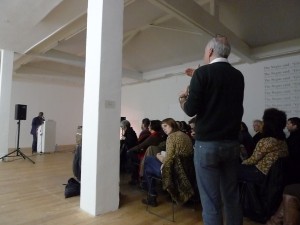Project ‘1975’ entails a theoretical program in which the disperse notions of post-colonialism in contemporary art are challenged. The kick-off of the theoretical backbone of Project ‘1975’ was a lecture by Paul Goodwin, curator of cross-cultural programmes at the Tate Britain.
Early in his talk Goodwin pointed out that he prefers not to be called a ‘cross-cultural curator’, because it sounds like he is the only one who is cross-cultural; he rather wants to be referred to by the official ‘curator of cross-cultural programmes’, as these words explain the core of a problematic faced by art museums nowadays: the term cross-cultural is particularly of use within the museum institution, since it is there where cultural diversity still needs to claim its grounds.
The context of Tate Britain is of course the cultural landscape of the United Kingdom, but many aspects of Goodwin’s lecture can be translated to the local situation. In the introduction SMBA’s curator Jelle Bouwhuis stated that “a certain disgust for the term multiculturalism is remarkable in the Netherlands.” Goodwin explained that in the UK a similar feeling stems from the idea that the policies of multiculturalism have fed domestic terrorism, as many notorious terrorists have been educated in Britain. In multiculturalism each culture can manifest itself openly, yet by celebrating cultures they are not taken seriously. In comparison to multicultural, the term cross-cultural is more open to the idea of the transmission of meanings by which cultural identities can grow rather than shrinking them down to monotonous unities. The idea of fixed cultures is to be challenged; everyone has to be self-critical. For representatives of public institutions such a critical awareness is particularly important.
What are the challenges Paul Goodwin is facing in his function at the Tate Britain? Goodwin mentioned that the history of art sometimes seems to be replaced by the history of exhibitions and also that curating is at the very centre of how we experience art. Therefore, as the curator of cross-cultural programmes, he constantly takes the following questions into consideration: How is art-knowledge constructed? How do we establish an ethic of difference? How can diversity as a critical practice contribute aesthetically? How can the language used inside the museum incorporate global perspectives? How do we promote diversity? Goodwin wants to challenge the intellectual basis of a museum from his position by thinking critically about the fundamental problems encountered in the making of exhibitions.
For several reasons Goodwin reprimands the concept of managing cultural diversity. In a museum power and knowledge are still often constructed along nationalist narratives. Managing diversity is linked to the idea of control, suitable to a colonial mind-set. Goodwin considers curating a very self-reflective practice, other than management, because of a different impulse to act. The problem in a managerial approach to cultural diversity is the focus on quantifying this diversity. How many different artists are shown? From such an approach the notion of difference is not questioned. Another problem from this perspective is the segmentation of the audience. To whom may the artworks speak? Again, the old notion of difference is perpetuated. In this non critical approach cultural difference can become a fetish.
Goodwin’s aspiration is to spark the thinking beyond the institutions, that will never be flexible enough for full contemporeinity, and to work on an evolution from within the framework of public services. Some may say that post-colonialism will lose its edge by institutionalization, but, according to Goodwin those are the ones who are not ready for a ‘Deleuzian, post-political approach of multiplicity’.
By Sanne Bovenlander


